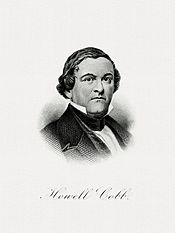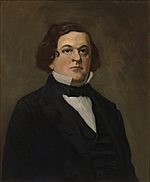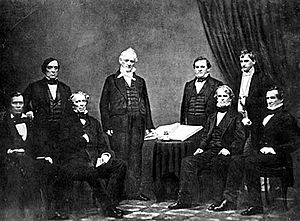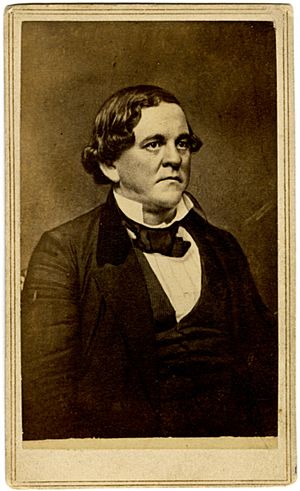Howell Cobb facts for kids
Quick facts for kids
Howell Cobb
|
|
|---|---|
 |
|
| President of the Confederate States Provisional Congress | |
| In office February 4, 1861 – February 18, 1862 |
|
| Preceded by | Position established |
| Succeeded by | Position abolished |
| 22nd United States Secretary of the Treasury | |
| In office March 7, 1857 – December 8, 1860 |
|
| President | James Buchanan |
| Preceded by | James Guthrie |
| Succeeded by | Philip Thomas |
| 40th Governor of Georgia | |
| In office November 5, 1851 – November 9, 1853 |
|
| Preceded by | George Towns |
| Succeeded by | Herschel Johnson |
| 19th Speaker of the United States House of Representatives | |
| In office December 22, 1849 – March 3, 1851 |
|
| Preceded by | Robert Winthrop |
| Succeeded by | Linn Boyd |
| Leader of the House Democratic Caucus | |
| In office December 4, 1843 – March 4, 1845 |
|
| Preceded by | John Winston Jones |
| Succeeded by | Linn Boyd |
| Member of the U.S. House of Representatives from Georgia's 6th district |
|
| In office March 4, 1855 – March 3, 1857 |
|
| Preceded by | Junius Hillyer |
| Succeeded by | James Jackson |
| In office March 4, 1845 – March 3, 1851 |
|
| Preceded by | Constituency established |
| Succeeded by | Junius Hillyer |
| Member of the U.S. House of Representatives from Georgia's at-large district |
|
| In office March 4, 1843 – March 3, 1845 Seat 5 |
|
| Preceded by | James Meriwether |
| Succeeded by | Constituency abolished |
| Personal details | |
| Born | September 7, 1815 Cherry Hill, Georgia, U.S. |
| Died | October 9, 1868 (aged 53) New York City, New York, U.S. |
| Political party | Democratic (Before 1851; 1853–1868) Constitutional Union (1851–1853) |
| Relatives | Thomas Cobb (brother) |
| Education | University of Georgia (BA) |
| Military service | |
| Allegiance | |
| Branch/service | |
| Years of service | 1861–1865 |
| Rank | |
| Unit | Army of Northern Virginia |
| Commands | Cobb's Brigade District of Georgia and Florida |
| Battles/wars | American Civil War |
Howell Cobb (born September 7, 1815 – died October 9, 1868) was an important American political leader. He was a member of the Democratic Party from the Southern states. Cobb served five terms in the United States House of Representatives. He was even the Speaker of the House from 1849 to 1851.
He also served as the 40th Governor of Georgia from 1851 to 1853. Later, he became the United States Secretary of the Treasury under President James Buchanan from 1857 to 1860. Howell Cobb is perhaps most famous for being one of the people who helped create the Confederacy. He was the President of the Provisional Congress of the Confederate States. This was when Southern states decided to leave the United States.
Contents
Early Life and Education
Howell Cobb was born in Jefferson County, Georgia, in 1815. His parents were John A. Cobb and Sarah (Rootes) Cobb. His family had roots in Wales. He grew up in Athens, Georgia, and went to the University of Georgia. There, he was part of the Phi Kappa Literary Society. After finishing his studies, he became a lawyer in 1836. He then worked as a prosecutor for Georgia's western judicial circuit.
In 1835, he married Mary Ann Lamar. Her family had many connections in the South. Howell and Mary Ann had eleven children together. Sadly, some of their children did not live past childhood.
Political Career
Serving in Congress
Cobb was elected to the U.S. House of Representatives as a Democrat four times. He led the House Committee on Mileage during his first term. He became the Speaker of the United States House of Representatives during his fourth term.
He supported President Andrew Jackson during the Nullification Crisis. This was a disagreement about whether states could ignore federal laws. Cobb also strongly supported President James K. Polk during the Mexican–American War. He believed that the practice of slavery should be allowed in new U.S. territories. However, when the Compromise of 1850 was made, he strongly supported it. This compromise tried to settle disagreements about slavery. Cobb, along with other Georgia politicians, convinced the state to accept the compromise. Because of this, he was elected Governor of Georgia.
Speaker of the House
Cobb became Speaker of the House on December 22, 1849. He was only 34 years old. In 1850, after President Zachary Taylor died, Millard Fillmore became president. For a short time, Cobb was next in line for the presidency. This was because the Vice President's job was empty. However, Cobb was not old enough to be president at 34. The law says a president must be at least 35.
Governor of Georgia
In 1851, Cobb left Congress to become the Governor of Georgia. He served in this role until 1853. In 1856, he wrote a book called A Scriptural Examination of the Institution of Slavery in the United States. This book discussed his views on slavery.
Return to Congress and Secretary of the Treasury

After being governor, Cobb was elected to Congress again. Then, President James Buchanan chose him to be the United States Secretary of the Treasury. He worked in this important role for three years. He resigned in December 1860. At one point, President Buchanan even thought Cobb could be the next president.
Founding the Confederacy
In 1860, Howell Cobb changed his mind about staying in the Union. He became a leader in the movement for Southern states to leave the United States. This was called secession. On February 4, 1861, Cobb was chosen to be president of a meeting of these states in Montgomery, Alabama. Under his leadership, these delegates wrote a new constitution for the new country they formed, the Confederacy. He led several meetings of the Confederate Provisional Congress. He later left this role to join the military when the war began.
Role in the American Civil War
Cobb joined the Confederate army as a colonel. He was later promoted to brigadier general in 1862. He was given command of a group of soldiers in the Army of Northern Virginia. From February to June 1862, he helped negotiate with Union officers. They worked on an agreement to exchange prisoners of war. His efforts helped create the Dix-Hill Cartel in July 1862. This agreement set rules for prisoner exchanges.
Cobb fought in several battles, including the Peninsula Campaign and the Seven Days Battles. His soldiers played a key role in the Battle of South Mountain. They helped slow down the Union army. His men also fought in the Battle of Antietam.
In October 1862, Cobb was sent to command troops in Florida. He was promoted to major general in September 1863. He then commanded troops in Georgia and Florida. He suggested building a large prisoner-of-war camp in southern Georgia. This led to the creation of Andersonville prison.
When General William T. Sherman's army marched through Georgia in 1864, Cobb commanded Georgia's reserve troops. In 1865, as the war was ending, he and his troops were sent to Columbus, Georgia. They tried to stop Wilson's Raid. He led the Confederate soldiers in the Battle of Columbus, Georgia, on April 16, 1865. This was a battle the Confederates could not win.
During Sherman's march, the Union army camped near Cobb's home. When Sherman found out it was Cobb's property, he ordered his soldiers to take Cobb's belongings and burn his house. Sherman saw Cobb as a major leader of the Confederacy.
Near the end of the war, General Robert E. Lee suggested allowing enslaved people to join the Confederate army. Cobb strongly disagreed with this idea. He believed that if enslaved people became soldiers, it would show that the whole reason for the Confederacy, which was based on the idea that black people were not equal, was wrong. He said, "You cannot make soldiers of slaves, or slaves of soldiers."
Cobb surrendered to the U.S. Army in Macon, Georgia, on April 20, 1865.
Later Life and Death
After the Civil War ended, Cobb went back home and continued his work as a lawyer. He was careful not to speak publicly about the Reconstruction period. This was the time when the Southern states were rebuilt and brought back into the Union. He waited until he received a pardon from the president. In early 1868, he received his pardon. He then began to speak out against the new laws that were part of Reconstruction. He gave many speeches criticizing these policies.
In the autumn of 1868, Cobb was on vacation in New York City. He sadly died there from a heart attack. His body was brought back to Athens, Georgia, and buried in Oconee Hill Cemetery.
Legacy
Howell Cobb's portrait used to be on display in the U.S. Capitol building. However, in 2020, the Speaker of the House, Nancy Pelosi, ordered that his portrait be removed from public display.
Cobb Family
The Cobb family had many important members in Georgia before and after the Civil War. Howell Cobb's uncle, also named Howell Cobb, was a U.S. Congressman and an officer in the War of 1812.
Howell Cobb's younger brother, Thomas Reade Rootes Cobb, was also a politician and soldier. He was killed during the Civil War. Thomas Willis Cobb, another relative, was a U.S. Congressman. Cobb County is named after him. Howell Cobb's niece, Mildred Lewis "Miss Millie" Rutherford, was a well-known educator. She was also a leader in the United Daughters of the Confederacy. Howell Cobb's daughter, Mary Ann Lamar Cobb Erwin, helped create the Southern Cross of Honor in 1899. This award was given to Confederate veterans.
See also
 In Spanish: Howell Cobb para niños
In Spanish: Howell Cobb para niños





